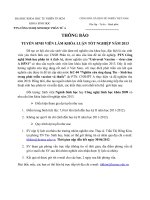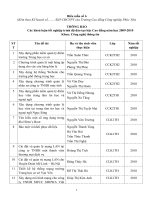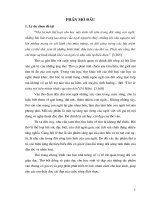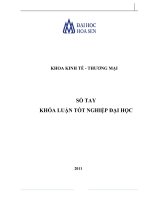- Trang chủ >>
- Sư phạm >>
- Sư phạm vật lý
Khoá luận tốt nghiệp
Bạn đang xem bản rút gọn của tài liệu. Xem và tải ngay bản đầy đủ của tài liệu tại đây (617.84 KB, 45 trang )
6
Magnetic Field Sensors Based on
Microelectromechanical Systems (MEMS)
Technology
Maria Teresa Todaro1, Leonardo Sileo1,2 and Massimo De Vittorio1,2,3
1National Nanotechnology Laboratory (NNL), Istituto Nanoscienze-CNR
2Center for Biomolecular Nanotechnologies UNILE, Istituto Italiano di
Tecnologia
3University of Salento, Lecce
Italy
1. Introduction
In the last decades magnetic field sensors have been developed and realized
for analyzing and controlling thousands of functions (Ripka, 2001), and they
have become a widespread presence in modern lifestyle. Numerous
applications in different fields of science, engineering, and industry rely on
the performance, ruggedness, and reliability of magnetic field sensors.
The applications of magnetic sensors depend on magnetic field dynamic
range and resolution and include position sensing, speed detection, current
detection, non-contact switching, space exploration, vehicle detection,
electronic compasses, geophysical prospecting, non-distructive testing,
brain function mapping (Lenz & Edelstein, 2006).
Nowdays there is an increasing requirement for magnetic devices with
improved sensitivity and resolution, trying to keep as low as possible their
cost and power consumption. Additionally there is the need to develop
compact devices with several sensors able to measure different parameters
including magnetic field, pressure, temperature, acceleration. In this way a
multifunctional device could be integrated on the same substrate containing
transducers and electronic circuits in a compact configuration without
affecting device performances.
In this context microelectromechanical systems (MEMS) technologies play
a prominent role for the development of a new class of magnetic sensors.
In general MEMS devices are miniaturized mechanical systems produced
using fabrication techniques already explored in the electronics industry.
The exploitation of MEMS technology for device fabrication not only
makes possible the reduction of the device dimensions on the order of
www.intechopen.com
micrometers, but also allows the integration of the mechanical and
electronic components on a single chip. In addition to the small device size
this involves other important advantages such as light weight, minimum
power consumption, low cost, better sensitivity and high resolution. This
technology was successfully employed for the realization of portable
devices such as gyroscopes (Chang et al., 2008), accelerometers (Li et al.,
2011), micromirrors (Singh et al., 2008), and pressure sensors (Mian & Law,
2010).
www.intechopen.com
104
Applications
Magnetic Sensors – Principles and
Magnetic field sensors based on MEMS technology, depending on their
operation principle and magnetic range, have a great potential for numerous
applications in several fields spanning from vehicle detection and control to
mineral prospecting and metal detection as well as to non-distructive testing
and medical diagnostics.
This paper aims at the description of current research status in magnetic
field sensors focusing on devices fabricated by exploiting MEMS
technologies. The paper presents advances in the classes of devices that take
advantage from these technologies to scale down magnetic sensors size,
namely resonant sensors, fluxgate sensors and Hall sensors.
Resonant sensors exploit Lorentz force principle on micromachined
structures excited at one of their resonating modes. These sensors can detect
magnetic fields with sensitivity up to 1 T and a maximum achievable
resolution of 1 nT.
Fluxgate sensors are inductively working sensors consisting of excitation
and sensing coils around a ferromagnetic core. Such sensors can detect static
and low frequency magnetic fields up to approximately 1 mT with a
maximum resolution of 100 pT.
Hall sensors are based on Hall effect transduction principle and measure
either constant or varying magnetic field. They have a magnetic field
sensitivity range from 1T to 1T.
Following the introduction, the paper is organized as follows. The second
section, is devoted to the resonant sensors, including the Lorentz force
operation principle, examples of realized devices reported in the literature
with an highlight on the employed technologies for the fabrication. Third
section is focused on fluxgate microsensors including operation principle,
state of the art and involved fabrication technologies. Fourth section is
dedicated to the description of the Hall effect and Hall magnetic sensors
employing MEMS technologies are reported. The fifth section describes the
possible applications of this new class of compact devices. Finally in the
section sixth the paper ends with the conclusion.
2. Resonant
magnetic sensors
Resonant sensors exploit Lorentz force of resonating micromachined
structures. These sensors can detect magnetic fields up 1 mT with a
resolution down to 1 nT. Such devices are normally based on MEMS
technologies, are small in size (order of millimetres), and promise all the
advantages related to the employment of fabrication microtechnologies
including multifuntionalities and integration of mechanical and electronic
components on a single chip.
Resonant magnetic field sensors use resonant structures that are excited at
their resonant frequencies by Lorentz forces. Such devices are able to give
an amplified response if excited at frequencies equal to the resonant
frequencies or vibrational modes of the structures (Bahreyni, 2008).
These structures commonly consist of clamped-free beams or clampedclamped beams or torsion/flexion plates. In figure 1 it is shown a schematic
diagram of the Lorentz force principle acting on a clamped-clamped beam
resonant structure. This device can be designed for example to resonate to
its first resonant frequency, associated to its first flexural vibration mode.
This beam, exposed to an excitation source with a frequency equal to its
first resonant frequency, will have a maximum deflection at its midpoint.
In order to
Magnetic Field Sensors Based on Microelectromechanical Systems (MEMS)
Technology
105
excite the device a metallic loop is placed on the clamped-clamped beam
surface where an excitation current (I) flows inside it with a frequency equal
to the first resonance frequency. When the beam is exposed to an external
magnetic field (Bx) in the x-direction, then a Lorentz force (FL) is
generated.
Fig. 1. Schematic diagram of the Lorentz force principle acting on a clampedclamped beam.
This force can be
determined as:
FL
IBxLy
(1)
where the flowing current can be expressed as:
I Irms2sin2 ft
(2)
where Ly is the length of the metallic loop perpendicular to the magnetic
field, Irms is the root mean square of the current I, f is the frequency and t is
the time.
The Lorentz force acts as an excitation source on the clamped-clamped
beam, causing an amplified deflection on the midpoint. Thus, the magnitude
of the beam deflection depends on the Lorentz force amplitude, which is
directly proportional to I and Bx.
The application of an external magnetic field alters deflection/torsion of
resonating structures with different shapes that is detected by exploiting
different readout techniques.
In fact such deflections/torsions result in strain which is related to the elastic
modulus of the structure material, to the geometrical characteristics of the
resonating structures and to the quality factor (Herrera-May et al. 2010).
The quality factor is an important parameter of the resonant structures. It
defines the bandwidth of the resonator relatively to its central resonant
frequency or equivalently it expresses the maximum amplitude of the
bending structure taking into account the different damping sources
(Elwenspoek & Wiegerink, 2001, Beeby et al., 2004). High quality factors
involve better device performance, better resolution and improved
insensitivity to the disturbances (Beeby et al., 2004).
Another parameter of interest in resonant structures is the resonance
frequency. Its determination can be obtained by using both analytical
models and simulation tools and
106
Applications
Magnetic Sensors – Principles and
depends on elastic modulus, density, deflection and geometrical features of
the resonant structure.
Moreover resonance frequencies are affected by residual stresses on the
structure (Weaver et al. 1990). For example thermal stresses inside resonant
devices (Hull, 1999) causes strains in the structures which in turn involve
(Sabaté et al., 2007) a shift of the resonant frequency of the structures.
Such sensors are typically fabricated in silicon and polysilicon and main
disadvantage of this technology is the resonance frequency shift due to
temperature changes and environmental pressure which requires
compensation electronic circuits and packaging under vacuum respectively.
To detect deflection of resonant structures different readout techniques have
been used including the employment of piezoresistive, optical or capacitive
techniques.
Piezoresistive sensing exploits changes in the resistance of piezoresistive
elements placed in the hinges of the resonant structure, to detect changes in
the output voltage signal as effect of strains originating from motions of
beams or plates due to the Lorentz force.
Herrera-May et al. (2009) reported on a magnetic field microsensor based
on a silicon resonant microplate (400 × 150 × 15 m 3) and four bending
microbeams (130 × 12 × 15 m3).
Figure 2 shows a schematic diagram of the fabrication process of the device.
The fabrication process is based on bulk micromachining technology on
(100) 4" silicon-on- insulator (SOI) wafers. The process starts by growing a
thin thermal oxide layer and depositing a silicon nitride layer on a SOI ntype substrate. The nitride layer is removed from the front side of the wafer
and is patterned on the backside (figure 2(a)). Using a second mask, boron
is implanted to create four p-type piezoresistors (figure 2(b)). A 1 μm- thick
oxide layer is then grown and patterned. The area contacts (120 × 120 μm 2)
are opened
(figure 3(c)) and then an aluminum layer is deposited and patterned to
define metallic lines and pads (figure 4(d)). At this time the silicon substrate
is etched from the backside using KOH that stops at the SOI buried oxide
(figure 2(e)), which is then removed.
Fig. 2. Schematic diagram of the fabrication process of a piezoresistive
resonant magnetic sensor reported by Herrera-May et al. (2009)
Magnetic Field Sensors Based on Microelectromechanical Systems (MEMS)
Technology
107
Finally, the SOI layer is etched by reactive ion etching (figure 2(f)) to define
the plate-beam structure.
Figure 3 shows a schematic design of the resonant magnetic field
microsensor reported by Herrera-May et al. (2009) with an highlight on the
plate-beam structure and its working principle.
Fig. 3. Schematic design of resonant magnetic field microsensor (left) and
highlight on the plate-beam structure and its working principle (right)
reported by Herrera-May et al. (2009).
One of the main elements of this sensor is the aluminum rectangular loop
deposited on the silicon plate. The Lorentz force causes a seesaw motion on
the microplate and the bending of microbeams. Four piezoresistors (p-type)
are connected in a Wheatstone bridge and two of these are active
piezoresistors located on the microbeams. The Lorentz force originates a
longitudinal strain on the two active piezoresistors changing their resistance.
The change in the resistance of the active piezoresistors produces an output
voltage shift of the Wheatstone bridge.
This sensor has a resonant frequency of 136.52 kHz, a quality factor of 842
at ambient pressure, a sensitivity of 0.403 μVμT -1, a resolution of 143 nT
with a frequency variation of 1 Hz, and power consumption below 10 mW.
However, the sensor registered an offset and linearity problems in the low
magnetic field range.
Tapia et al. (2011) reported on a piezoresistive resonant magnetic
microsensor with seesaw rectangular loop of beams reinforced with
transversal and longitudinal beams. This device was designed to be compact
and to have high resolution for neurobiological applications. Characteristics
of this microsensor are a resonant frequency of 13.87 kHz with a quality
factor of 93, a resolution of 80 nT, a sensitivity of 1.2 VT -1 and a power
consumption of 2.05 mW at ambient pressure. This sensor requires a simple
signal processing circuit.
Other examples of piezoresistive magnetic sensors on the microscale have
been reported in the literature (Beroulle et al. (2003), Sunier et al. (2006)).
Among the resonant magnetic sensors, there are some of them exploiting the
optical detection.
108
Applications
Magnetic Sensors – Principles and
Keplinger et al. (2004) reported a resonant magnetic field sensor using Ushaped silicon microbeams and an optical readout system. Figure 4 shows a
schematic sketch of the device reported by these authors.
Fig. 4. Schematic sketch of the resonant magnetic sensor with optical readout
reported by Keplinger et al. (2004).
Devices are processed by both surface micromachining and bulk
micromachining techniques. The etching process has been also used to form
the groove for the optical fibers. The microbeams contain a gold loop with a
thickness of 500 nm. A magnetic field and an ac electrical current generate
a Lorentz force, which bends the microbeams. These deflections are
measured by optical sensing using an arrangement consisting of two fibers
to avoid interference of reflected light. Figure 4 shows a design, in which
the emitted light beam is reflected only once at the microbeam front side.
This sensor can measure magnetic fields from 10 mT to 50 T at moderate
excitation amplitudes. It can be used in harsh environments under
mechanical vibrations and low temperatures. The device has a resonant
frequency around 5 kHz, a resolution of 10 mT, and a power consumption of
few milliwatts. The device needs high current magnitudes thus increasing
the temperature and deformation at the silicon microbeam, with a possible
resonant frequency shift.
Another example of magnetic sensor based on MEMS technology and
having an optical readout has been reported by Wickenden et al. (2003).
Ren et al. (2009) reported on a resonant device exploiting the capacitive
readout. The magnetic field sensor has been fabricated by using
conventional MEMS technology and silicon-to-glass anodic bonding
process. The device consists of a low-resistivity silicon plate suspended over
a glass substrate by two torsional beams, as shown in figure 5. This silicon
plate acts as electrode of sensing capacitances. Au capacitance plates are
fabricated on the glass substrate and a multi-turn coil (Cr and Au layers) is
deposited on silicon-plate surface. The Lorentz force causes an oscillating
motion of silicon plate around the torsional beams, which produces a
capacitance shift between the Au electrodes and the silicon plate. A
capacitance detection circuit measured the capacitance change that depends
on the magnitude and the direction of the external magnetic field. This
sensor required a vacuum
Magnetic Field Sensors Based on Microelectromechanical Systems (MEMS)
Technology
109
packaging to increase its performance. For a pressure of 10 Pa and 150 mV
driving voltage amplitude, the microsensor has a resolution of 30 nT in the
linear range from 3 T to 30 µT, a sensitivity of 481 mVT -1, a resonant
frequency close to 1380 Hz, and a quality factor around 2500. Nevertheless,
it presented a non-linear response from 0 to 3 µT.
Fig. 5. Schematic design of the resonant magnetic sensor exploiting the
capacitive sensing and reported by Ren et al. (2009).
Brugger et al. (2009) reported on a complex magnetic field sensor with a
size of 7.5 mm 3.2 mm, consisting of an electrostatically driven silicon
resonator characterized by interdigitated combs for electrostatic excitation
and capacitive detection, an amorphous magnetic concentrator and a pair of
planar coils. It requires a complex fabrication process combining MEMS
technology based on a silicon-on-insulator (SOI) substrate, the epoxy- resinbased attachment of a thin amorphous magnetic ribbon structured by wet
chemical etching, micropatterning of the magnetic concentrator by UV-laser
and vacuum packaging.. For a coil current of ±120 mA, the device offers a
sensitivity of 1.91 MHzT-1 and a resolution of 1.3 μT. Under a pressure of
10-5 mbar, this microsensor presents a sensitivity of 1 MHzT -1, a resolution
of 400 nT, and a quality factor around 2400. It does not need a complex
feedback and modulation electronics.
J. Kyynäräinen et .al. (2008) reported on resonant micromechanical
magnetometers based on capacitive detection for 3D electronic compasses.
The sensors has been fabricated by exploiting aligned direct bonding of a
double side polished silicon wafer and a SOI wafer. Devices operated in
vacuum to reach high enough Q values. Magnetometers measuring the field
component along the chip surface have a flux density resolution of about 10
nT/√Hz
at a coil current of 100 A. Magnetometers measuring the field component
perpendicular to the chip surface are currently less sensitive with a
flux density resolution of about 70 nT/√Hz.
There are in the literature other works reporting on capacitive sensing-based
resonant magnetic sensors (Emmerich et al. (2000), Kádár et al. (1998),
Tucker et al. (2000)).
110
Applications
3. Fluxgate
Magnetic Sensors – Principles and
sensors
Fluxgate sensors are inductively working sensors composed of excitation
and sensing coils around a ferromagnetic core for detecting static and low
frequency fields.
Fluxgate sensors can detect magnetic fields up to approximately 1 mT with
a maximum resolution of 100 pT. Classical fluxgate sensors are expensive
and have a big size. However in recent years a great effort was devoted to
manufacturing micro fluxgate sensors using microfabrication technologies.
Beside the small size, the advantages of micro fluxgate sensors are small
weight, low power consumption, low cost in mass production and the
possibility of on-chip electronics integration. The principal disadvantage is
related to the fluxgate sensor parameters dramatically degrading when
reducing the core size, which leads to low sensitivity and high noise level.
The fluxgate operation principle can be illustrated with the simple layout in
figure 6 ( Ripka, 2001). A ferromagnetic core immersed in an external
magnetic field Bx is surrounded by an excitation coil which provides an ac
excitation current I. This current periodically saturates the soft magnetic
material of the sensor core at a frequency twice the excitation frequency.
Fig. 6. The basic fluxgate principle.
A voltage in the pick-up coil (Vi) is generated due to the changing magnetic
flux (Φ). From the Faraday’s law:
d d(NA0
V
r (t)H(t))
(3)
i dt
dt
where µr is the relative permeability, 0 is the vacuum permeability, N is
the number of turns and A is the cross sectional area, that we consider
here as a constant.
By expanding, the equation (3) becomes:
(4)
NA0rdH(t)
V 0Hd
NA
r (t)
i
dt
dt
Magnetic Field Sensors Based on Microelectromechanical Systems (MEMS)
Technology
111
where H is the field in the core material and is lower than the measured field
Hex in the open air due to demagnetization (Bozorth & Chapin (1942)):
H Hex - DM
(5)
where D is the demagnetising factor, Hex = Bx/µ0 and M is the
magnetization.
The first term in the equation (4) is the basic induction effect, and causes
interference. Fluxgate operation is based on the second term, due to the
variation of the core permeability with the excitation field. By considering
the effect of demagnetization, the basic fluxgate equation becomes
(Primdahl, 1979):
V NA H
i
0
dr
1(t)
D
ex
(1 r D( (t) - 1))2 dt
(6)
The output voltage is on the second harmonics of the excitation frequency,
as permeability reaches its minimum and maximum twice in each excitation
cycle.
In accordance with the shape of the magnetic core, parallel-type fluxgate
sensors fall into the categories of single core, dual core, ring-type core,
racetrack type core (Ripka, 2001). The configuration of figure 6 is single
core type. In order to eliminate the induction effect, a dual core
configuration has been proposed, as showed in figure 7.
Fig. 7. Dual core (left) and ring type (right) configurations of a fluxgate
sensor.
The driving coil is wound in opposite direction around the two cores, thus
the induced magnetization fields are opposite in sign. If no external field is
applied, the voltage induced in the sensing coil is zero in the ideal case.
When an external field is present, a voltage is induced due to the differential
change of the permeability (Primdahl, 1979).
High sensitivity can be achieved by increasing the number of turns N (if N
is very high coil parasitic capacitance limits the sensitivity), by decreasing
the demagnetization factor D or by increasing the excitation frequency,
because (dHex/dt) ~ f up to frequency values that make eddy currents
negligible.
Such devices can be also classified in parallel type and orthogonal type
fluxgate sensors depending on the excitation field is parallel or
perpendicular to the sensitive axis of the sensor.
112
Applications
Magnetic Sensors – Principles and
Typically these devices contain solenoid systems wiring magnetic cores
consisting of a permalloy or an amorphous material.
Figure 7 shows also the ring type configuration. The closed geometry of the
ring core has a lower sensitivity but better noise performance, due to the
absence of open ends.
A closed core made with oval geometry (race-track fluxgate sensor) lead to
a lower demagnetization factor, then to higher sensitivity and less sensitivity
to perpendicular fields.
In the orthogonal fluxgate the excitation coil is absent, and the sensor is
excited directly by the current flowing through the core.
Three basic types of miniature fluxgate can be distinguished (Ripka &
Janosĕk, 2010): plane type sensors with flat coils, PCB-based devices with
solenoids made by tracks and vias and 3D type sensors with micro
solenoids.
While plane type sensors are typically fabricated by standard CMOS
processes, MEMS microfluxgate sensors exploit advanced microfabrication
technologies to realize three- dimensional coils or three-dimensional cores.
One of the first work which proposed MEMS technology for the
development of fluxgate sensors has been reported by Liakopoulos & Ahn,
(1999). In this work the authors presented a micro-fluxgate magnetic sensor
based on micromachined toroidal type planar coils. In this fluxgate sensor a
rectangular-ring shaped magnetic core has been chosen. The operation
principle is based on the second harmonic. Excitation and sensing coils as
well as permalloy magnetic cores were fabricated by a UV-LIGA thick
photoresist process and electroplating techniques to realize a planar threedimensional magnetic fluxgate sensor on silicon wafers. Excellent linear
response over the range of -500 mT to +500 mT, with a sensitivity of 8360
VT-1 and a resolution of 60 nT was achieved with this device. The total
response range of the sensor is -1.3 to +1.3 mT. The power consumption is
around 100 mW for an operational frequency range of 1-100 kHz.
Woytasik et al. (2006) proposed an alternative fabrication process based on
copper micromoulding to realize planar microcoils and microsolenoids for
MEMS based magnetic sensors on flexible substrate. Figure 8 shows
main steps for solenoid fabrication process.
The main steps for solenoids fabrication consist of the realization of the
bottom conductor lines and of the air bridge by copper electrodeposition
overflow. The second exposure process uses a gray-tone mask to vary
spatially the exposure dose deposited into the photoresist and then to
modulate the remaining photoresist thickness after development. The
process ends with mould removal.
This technology has been employed for the realization of a micromachined
fluxgate sensor (Wu & Ahn, 2008).
The sensor, schematically shown in figure 9, consists of a 30 µm thick
electroplated permalloy core, with 56 excitation turns giving a total
resistance of 2 Ω and 11 sensing turns. A sensitivity of 650 VT -1 was
achieved for a 5.5-mm-long sensor with 14 mW power consumption. The
noise is 32 nT/√Hz @1Hz , and the practical resolution is 1 µT.
Magnetic Field Sensors Based on Microelectromechanical Systems (MEMS)
Technology
113
Fig. 8. Main steps of solenoid fabrication process reported by Woytasik et al.
(2006).
Fig. 9. Schematic view of the MEMS based fluxgate sensor proposed by Wu
& Ahn, (2008).
Other examples of MEMS-based fluxgate devices have been reported by
Chong Lei et al. (2009) and Kirchhoff & Büttgenbach (2010).
Most of the microfluxgate exploiting MEMS technologies are parallel
sensors.
A miniature orthogonal fluxgate realized by exploiting MEMS technologies
with a planar structure formed by a permalloy layer electrodeposited on a
rectangular copper conductor
114
Applications
Magnetic Sensors – Principles and
has been reported by Zorlu et al. (2007). The sensor structure is reported in
figure 10. The sensor core is only 1 mm in length and the sensor has two flat
60 turn pickup coils.
The overall dimension of the sensor chip is 1.8 0.8 mm, the sensitivity is
0.51 mVmT-1 in a linear operating range of 200 T. The noise was
95nT/Hz@1Hz with an excitation power consumption of 8.1 mW.
Fig. 10. Sensor structure the orthogonal microfluxgate reported by Zorlu at al.
(2007).
4. Hall sensors
Hall sensors exploits Hall effect as trasduction principle to detect magnetic
field. They are commonly fabricated by standard Complementary MetalOxide Semiconductor (CMOS) technology. In general, they are applicable
in a range from 1 µT to 1 T and have a die size less than one millimeter.
These sensors can measure either constant or varying magnetic field. The
frequency limit is around 1 MHz and operate well in a wide temperature
range (Ripka & Tipek, 2007).
The Hall effect is based on the Lorentz force felt by charge carriers moving
in a magnetic field. Figure 11 shows the schematic of the classical
configuration where a thin slab of a conductor is placed in a magnetic field
Bz. When a current flows in the x direction, the Lorenz force acts in the y
direction, determining a charge distribution that counterbalances the force.
Therefore a (Hall) voltage VH builds up, as shown in figure 11.
Fig. 11. Hall effect principle.
In the case of a constant current drive, the Hall voltage is given by:
Magnetic Field Sensors Based on Microelectromechanical Systems (MEMS)
Technology
115
V V
B
(7)
I
z
H OFF
en2D
where VOFF is the Hall voltage at zero magnetic field (offset voltage) and
n2D is the sheet charge concentration given by the product of the bulk
charge concentration n and the thickness of the slab t:
+
n2D nt
(8)
If the current is constant, lower charge carriers concentration involves
higher carriers speed resulting in an higher Lorentz force. Therefore low
charge carrier concentration leads to high Hall voltage, thus justifying the
extensive employment of semiconductor materials for Hall magnetic sensors
with respect to metals.
The current related sensitivity is a key figure of merit of a Hall sensor and can
be defined as:
SI
(9)
As the Hall voltage is related only to the z-axis magnetic field component,
Hall magnetic sensors are basically uniaxial devices. Silicon based Hall
sensors are widely employed, due to the suitability of integration with
electronics. However, magnetic sensors based on silicon may have intrinsic
limits to their sensitivity and resolution, which may limit future performance
gains. In addition, they need temperature compensation circuits that can
include temperature sensor and operational amplifiers (op-amps).
MEMS technology has been employed in this class of devices in order to
solve some of their limitations and to find alternatives to silicon as structural
material. For example polymer- based devices are interesting alternatives to
silicon, particularly when the polymer materials can be functionalized for
enhanced specific material properties (e.g, optical, electrical, and
mechanical). Mouaziz et al. (2006) proposed the realization of SU-8
cantilevers with an integrated Hall-probe for advanced scanning probe
sensing applications. To this purpose an innovative release method of
polymer cantilevers with embedded integrated metal electrodes has been
employed. Figure 12 shows the device fabrication process. On the silicon









